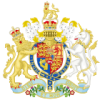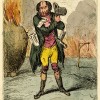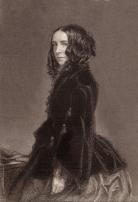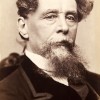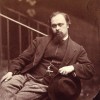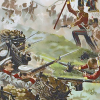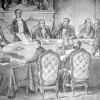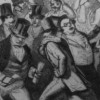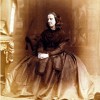EN316: Revolution and Empire: British Literature from 1660-1900
Created by Stacey Kikendall on Sun, 02/07/2021 - 17:58
This timeline presents important dates and events from the Restoration up through the end of the Victorian period, with special reference to authors and their works we read in class.
Timeline
Chronological table
| Date | Event | Created by | Associated Places | |
|---|---|---|---|---|
| 15 Nov 1819 |
Simultaneous Scottish radical meetingsOn 15 November 1819, simultaneous radical meetings occurred at Paisley, Glasgow, and other locations across Scotland. Articles |
Dave Rettenmaier | ||
| 30 Dec 1819 |
Gag Acts
Articles |
Dave Rettenmaier | ||
| 1820 |
Ode on a Grecian UrnWritten by John Keats |
Stacey Kikendall | ||
| 1820 |
George IV becomes KingAfter serving as Regent for years, he eventually becomes King when his father dies. |
Stacey Kikendall | ||
| 5 May 1821 |
Death of NapoleonNapoleon Bonaparte died on 5 May 1821 while in Exile on the island of Saint Helena. Image: Horace Vernet, Napoleon on his Death Bed (1826). |
Dino Franco Felluga | ||
| 16 Jun 1824 |
Society for Protection of Animals foundedOn 16 June 1824, founding of the Society for the Protection of Animals (SPCA) in London. The Society became the Royal Society in 1840, when it was granted a royal charter by Queen Victoria, herself strongly opposed to vivisection. ArticlesRelated ArticlesSusan Hamilton (U Alberta), “On the Cruelty to Animals Act, 15 August 1876″ Philip Howell, “June 1859/December 1860: The Dog Show and the Dogs’ Home” Mario Ortiz-Robles, “Animal Acts: 1822, 1835, 1849, 1850, 1854, 1876, 1900″ |
Dave Rettenmaier | ||
| Apr 1825 |
Stock market crashOn April 1825, the British stock market began to crash. After the speculative bubble reached its peak, falling Bank of England gold reserves and a collapse in stock prices lead to panic by the end of the year. Related ArticlesAngela Esterhammer, “1824: Improvisation, Speculation, and Identity-Construction” |
Dave Rettenmaier | ||
| Dec 1825 |
Bank failures in London
ArticlesAlexander J. Dick, “On the Financial Crisis, 1825-26″ Related ArticlesAngela Esterhammer, “1824: Improvisation, Speculation, and Identity-Construction” Lana L. Dalley, “On Martineau’s Illustrations of Political Economy, 1832-34″ |
Dave Rettenmaier | ||
| 1828 |
Test Act RepealedParliamentary repeal of the Test and Corporation Acts excluding Dissenters from state offices |
Stacey Kikendall | ||
| 1 Apr 1829 |
Roman Catholic Relief Act
The Catholic Relief Act of 1829 allowed Catholics to become Members of Parliament and to hold public offices, but it also raised the property qualifications that allowed individuals in Ireland to vote. The passage of the Catholic Relief Act marked a shift in English political power from the House of Lords to the House of Commons. The Act was led by the Duke of Wellington and passed despite initially serious opposition from both the House of Lords and King George IV. ArticlesRelated ArticlesCarolyn Vellenga Berman, “On the Reform Act of 1832″ Sean Grass, “On the Death of the Duke of Wellington, 14 September 1852″ |
Dave Rettenmaier | ||
| 1830 |
Death of George IV, William IV becomes KingBrother of George IV, son of George III |
Stacey Kikendall | ||
| 1 Jan 1830 |
Principles of Geology
Lyell’s work, though contested, establishes the preeminence of Uniformitarian principles in the interpretation of Geological phenomena, and allows vast temporal scope for Charles Darwin’s subsequent model of evolutionary development. ArticlesMartin Meisel, "On the Age of the Universe" Related ArticlesNancy Armstrong, “On Charles Darwin’s The Descent of Man, 24 February 1871″ Ian Duncan, “On Charles Darwin and the Voyage of the Beagle” Anna Henchman, “Charles Darwin’s Final Book on Earthworms, 1881” Cannon Schmitt, “On the Publication of Charles Darwin’s On the Origin of Species, 1859″ |
Dave Rettenmaier | ||
| 26 Jun 1830 |
Death of King George IV
Related Articles |
Dave Rettenmaier | ||
| Aug 1830 to Dec 1830 |
Swing Riots
Related ArticlesCarolyn Lesjak, "1750 to the Present: Acts of Enclosure and Their Afterlife" (forthcoming) |
Dave Rettenmaier | ||
| 15 Sep 1830 |
Opening of Liverpool & Manchester Railway
Articles
|
Dave Rettenmaier | ||
| 1831 |
A History of Mary PrinceStory by Mary Prince, transcribed by Suzanna Strickland, edited by Thomas Pringle |
Stacey Kikendall | ||
| Sep 1831 to Dec 1832 |
Cholera EpidemicThe first major cholera pandemic to cross the Channel began in Sunderland in September 1831, spread throughout the country, and was not determined to be over until more than a year later, in December of 1832. Articles |
Dave Rettenmaier | ||
| Oct 1831 to Oct 1836 |
Darwin's voyage on the Beagle
ArticlesNancy Armstrong, “On Charles Darwin’s The Descent of Man, 24 February 1871″ Ian Duncan, “On Charles Darwin and the Voyage of the Beagle” Anna Henchman, “Charles Darwin’s Final Book on Earthworms, 1881” Cannon Schmitt, “On the Publication of Charles Darwin’s On the Origin of Species, 1859″ Related ArticlesDaniel Bivona, “On W. K. Clifford and ‘The Ethics of Belief,’ 11 April 1876″ |
Dave Rettenmaier | ||
| 29 Aug 1833 |
Slavery Abolition Act
Articles |
Dave Rettenmaier | ||
| 29 Aug 1833 |
Factory Act
ArticlesRelated Articles |
Dave Rettenmaier | ||
| 28 May 1836 |
Elizabeth Barrett Browning dinner with WordsworthOn 28 May 1836, Elizabeth Barrett Browning met William Wordsworth at a literary dinner in London; EBB's cousin, John Kenyon, was the host and the event most likely occurred at Kenyon's main residence at the time: 39 Devonshire Place, London, which is right around the corner from EBB's residence at the time: 50 Wimpole Street. See the associated map. |
Dino Franco Felluga | ||
| 1 Aug 1836 |
Newspaper Act
Related ArticlesElaine Hadley, “On Opinion Politics and the Ballot Act of 1872″ |
Dave Rettenmaier | ||
| Feb 1837 to Apr 1839 |
Oliver Twist
Related ArticlesHeidi Kaufman, “1800-1900: Inside and Outside the Nineteenth-Century East End” |
Dave Rettenmaier | ||
| 17 Aug 1839 |
Act on Custody of Infants
Related ArticlesRachel Ablow, “‘One Flesh,’ One Person, and the 1870 Married Women’s Property Act” Kelly Hager, “Chipping Away at Coverture: The Matrimonial Causes Act of 1857″ Jill Rappoport, “Wives and Sons: Coverture, Primogeniture, and Married Women’s Property” |
Dave Rettenmaier | ||
| Feb 1840 |
First pupil-teacher training school, Battersea, establishedWith a fellow reformer, E. Carleton Tuftnell, Kay-Shuttleworth established in February 1840 the first pupil-teacher training school in Battersea. This system was later extended to schools administered by the National and British Societies. ArticlesFlorence S. Boos, “The Education Act of 1870: Before and After” |
Dave Rettenmaier | ||
| 17 Jul 1841 |
Punch launchedOn July 17 1841, Punch, a mass-circulation periodical, was launched. Articles |
Dave Rettenmaier | ||
| 14 May 1842 |
The Illustrated London News launched
Articles |
Dave Rettenmaier | ||
| Sep 1848 |
Pre-Raphaelite Brotherhood founded
Related ArticlesElizabeth Helsinger, “Lyric Poetry and the Event of Poems, 1870″ Morna O’Neill, “On Walter Crane and the Aims of Decorative Art” Linda M. Shires, "On Color Theory, 1835: George Field’s Chromatography" |
Dave Rettenmaier |
|
|
| Oct 1848 to Dec 1849 |
Cholera EpidemicThe second major cholera epidemic in the UK began in Scotland in October 1848 and is generally agreed to have largely subsided in the UK by the end of 1849. Articles |
Dave Rettenmaier | ||
| Jun 1850 |
In Memoriam
Related Articles |
Dave Rettenmaier | ||
| 29 Sep 1850 |
Pius IX restores England’s ecclesiastical hierarchyOn 29 September 1850, Pius IX restored England’s ecclesiastical hierarchy; the post-seventeenth-century system of Vicars Apostolic was replaced with a hierarchy in line with the system still in place in Ireland. This change contributed to the so-called Papal Aggression over the years 1850-52, a campaign against Roman Catholocism. ArticlesMiriam Burstein, “The ‘Papal Aggression’ Controversy, 1850-52″ Related ArticlesBarbara Charlesworth Gelpi (Stanford), “14 July 1833: John Keble’s Assize Sermon, National Apostasy” |
Dave Rettenmaier | ||
| Jan 1851 |
London Labour and the London Poor
ArticlesHeidi Kaufman, “1800-1900: Inside and Outside the Nineteenth-Century East End” |
Dave Rettenmaier | ||
| 5 Sep 1852 |
Manchester Public Library opensON 5 Sept 1852, the Manchester Public Library opened. This was Britain’s first free public lending library, opened under the 1850 Public Libraries Act. Related ArticlesAmy Woodson-Boulton, “The City Art Museum Movement and the Social Role of Art” |
Dave Rettenmaier | ||
| 28 Mar 1854 |
Britain declares war against RussiaOn 28 March 1854, Britain declares war against Russia, thus entering the Crimean War. Image: Russo-British skirmish during Crimean War (anonymous plate). This image is in the public domain in the United States because its copyright has expired. In 1854, in defense of the Turks and of British access to eastern trade routes, Britain entered into war in the Crimea. The two-year campaign represented the nation’s first major military engagement since the end of the Napoleonic wars. It thus sheds light on mid-Victorian attitudes towards national identity, offering a counter-narrative to views of the 1850s dominated by responses to the Great Exhibition of 1851. As literary and visual representations of the war reveal, reactions to this conflict were both more nuanced and more ambivalent than our preconceptions about Victorian jingoism might anticipate. ArticlesStefanie Markovits, "On the Crimean War and the Charge of the Light Brigade" |
Dave Rettenmaier | ||
| 10 Jun 1854 |
Sydenham Crystal Palace opensOpening of the Crystal Palace at Sydenham on 10 June 1854. Image: The Crystal Palace on fire (30 November 1936; author unknown). This image is in the public domain in the United States because its copyright has expired. The resurrection of the Crystal Palace of 1851 in its new setting at Sydenham, with an expanded architectural complex and enhanced functional brief, embodies the Victorian emphasis upon visuality as a means of acquiring and conveying knowledge. In addition, the new Crystal Palace was shaped by prevailing concepts of rational recreation and beneficial commerce that insisted that private and public interests could be simultaneously satisfied and lead to a stronger nation and even Empire. ArticlesAnne Helmreich, "On the Opening of the Crystal Palace at Sydenham, 10 June 1854" Related ArticlesAudrey Jaffe, "On the Great Exhibition" Aviva Briefel, "On the 1886 Colonial and Indian Exhibition" Anne Clendinning, “On The British Empire Exhibition, 1924-25″ |
Dave Rettenmaier | ||
| 14 Mar 1856 |
Petition for Reform of Married Women’s Property LawOn 14 March 1856, presentation of the Petition for Reform of the Married Women’s Property Law, 1856. The petition began the joint effort by lawmakers and public women to grant married women control of their own wealth. ArticlesJill Rappoport, “Wives and Sons: Coverture, Primogeniture, and Married Women’s Property” Related ArticlesRachel Ablow, “‘One Flesh,’ One Person, and the 1870 Married Women’s Property Act” Anne D. Wallace, “On the Deceased Wife’s Sister Controversy, 1835-1907″ |
Dave Rettenmaier | ||
| 30 Mar 1856 |
Treaty of ParisOn 30 March 1856, signing of the Treaty of Paris, ending the Crimean War. Image: Treaty of Paris, the participants (Contemporary woodcut, published in Magazin Istoric, 1856). This image is in the public domain in the United States because its copyright has expired. ArticlesStefanie Markovits, "On the Crimean War and the Charge of the Light Brigade" |
Dave Rettenmaier | ||
| 15 Nov 1856 |
Aurora Leigh
ArticlesMarjorie Stone, “The ‘Advent’ of Aurora Leigh: Critical Myths and Periodical Debates” |
Dave Rettenmaier | ||
| 10 May 1857 to 20 Jun 1858 |
Indian Uprising
ArticlesPriti Joshi, “1857; or, Can the Indian ‘Mutiny’ Be Fixed?” Related ArticlesJulie Codell, “On the Delhi Coronation Durbars, 1877, 1903, 1911″ |
Dave Rettenmaier | ||
| 25 May 1857 to 25 Jun 1857 |
Pre-Raphaelite Art Exhibit
Related Articles |
Dave Rettenmaier | ||
| 24 Aug 1857 |
Start of 1857 financial crisis in the US
ArticlesLynn Shakinovsky, “The 1857 Financial Crisis and the Suspension of the 1844 Bank Act” Related ArticlesCrosby, Mark. “The Bank Restriction Act (1797) and Banknote Forgery” |
Dave Rettenmaier | ||
| 28 Aug 1857 |
Matrimonial Causes Act of 1857
ArticlesKelly Hager, “Chipping Away at Coverture: The Matrimonial Causes Act of 1857″ Related ArticlesRachel Ablow, “‘One Flesh,’ One Person, and the 1870 Married Women’s Property Act” Jill Rappoport, “Wives and Sons: Coverture, Primogeniture, and Married Women’s Property” |
Dave Rettenmaier | ||
| 27 Oct 1857 |
Start of the 1857 financial crisis in England
ArticlesLynn Shakinovsky, “The 1857 Financial Crisis and the Suspension of the 1844 Bank Act” Related ArticlesCrosby, Mark. “The Bank Restriction Act (1797) and Banknote Forgery” |
Dave Rettenmaier | ||
| 1858 |
English Woman’s Journal first published
Articles |
Dave Rettenmaier | ||
| 24 Nov 1859 |
On the Origin of Species
ArticlesNancy Armstrong, “On Charles Darwin’s The Descent of Man, 24 February 1871″ Ian Duncan, “On Charles Darwin and the Voyage of the Beagle” Anna Henchman, “Charles Darwin’s Final Book on Earthworms, 1881” Martin Meisel, "On the Age of the Universe" Cannon Schmitt, “On the Publication of Charles Darwin’s On the Origin of Species, 1859″ Related ArticlesDaniel Bivona, “On W. K. Clifford and ‘The Ethics of Belief,’ 11 April 1876″ |
Dave Rettenmaier | ||
| Mar 1862 |
Goblin Market and Other Poems PublishedGoblin Market is a Victorian narrative poem written by Christina Rossetti and illustrated by her brother Dante Gabriel. Rossetti felt that the collaboration with her brother was crucial to her overall work, that she deliberately delayed the publication until Dante Garbiel’s illustrations were ready for press. He designed a total of two illustrations, the frontispiece and title page, for The Goblin Market. Both images were pressed using wood engravings, evoking the pre-raphaelite designs popular during the 1860’s. The passages appeal to the senses through vivid descriptions of colours, textures, aromas and taste. Critics assigned the poem to various general categories over the following decades and throughout the twentieth century. It was first viewed as a fairytale but was later viewed as an allegorical piece. Feminist critics often analyzed the poem’s social commentary on gender relations and the relationship between two sisters. Later in the nineteenth century, readers, reviewers, illustrators, and composers began to focus on the poem’s powerful aesthetic qualities. Its sensuous patterns, religious images, and social implications inspired the focus of school studies and as well as musical settings and performances. The power of its visual images, and the two wood-engraved designs by Dante Gabriel Rossetti in the poem’s first publication, turned to evoke numerous artistic interpretations, ranging from stained glass windows to gift books.
Curated by Kisha Rendon, Joseph Pereira, and Payton Flood Public Domain; source: COVE Goblin Market edition by Lorraine Janzen Kooistra, Antony Harrison |
Payton Flood | ||
| Jul 1866 |
Permanent transatlantic cable establishedIn July 1866, in the aftermath of the Civil War, a permanent transatlantic cable was re-established after a failed attempt in 1858. Articles |
Dave Rettenmaier | ||
| 15 Aug 1867 |
Second Reform Act
ArticlesJanice Carlisle, "On the Second Reform Act, 1867" Related ArticlesCarolyn Vellenga Berman, “On the Reform Act of 1832″ Elaine Hadley, “On Opinion Politics and the Ballot Act of 1872″ |
Dave Rettenmaier | ||
| 26 Jul 1869 |
Poor Rate Assessment and Collection Act
Articles |
Dave Rettenmaier | ||
| Feb 1870 |
Elementary Education Act
Related Articles |
Dave Rettenmaier |

